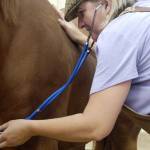Dourine in Horses

All horses imported into the United States are tested for dourine, except if imported from Iceland, Canada, Australia, or New Zealand. Dourine occurs in Africa, the Middle East, South America, Asia, and southeastern Europe.
Dourine is caused by a protozoan, Trypanosoma equiperidum. Dourine is a venereal disease and is spread during natural or artificial breeding, foaling, and in the milk of infected mares. Clinical signs of dourine can be nonspecific and include fever (temperature greater than 101.5°F [38.6°C]), conjunctivitis (swelling or redness around the eyeball), weight loss, skin plaques that may become depigmented, and neurologic signs. Affected animals discharge pus from their vulva (females) or urethra (males) and have severe swelling of their genitalia. Approximately 50-70% of infected horses die. Donkeys and mules are more resistant to dourine than horses.
Trypanosoma equiperidum is spread in reproductive tract secretions. Affected mares can infect their foals during foaling or through milk. Animals that recover can become inapparent carriers and intermittently shed the organism. There are several blood tests to detect antibodies against T. equiperidum. The complement fixation test is most commonly used for international transport of horses. Control of dourine involves recognition and testing of suspected cases, removal of infected animals from breeding (both artificial insemination and natural cover), and strict quarantine of suspected cases. Quinapyramine sulfate or melarsamine hydrochloride can be used to treat dourine, but in most countries, confirmed cases are euthanized to prevent further spread of the disease and because recovered horses can still transmit dourine to other horses.








